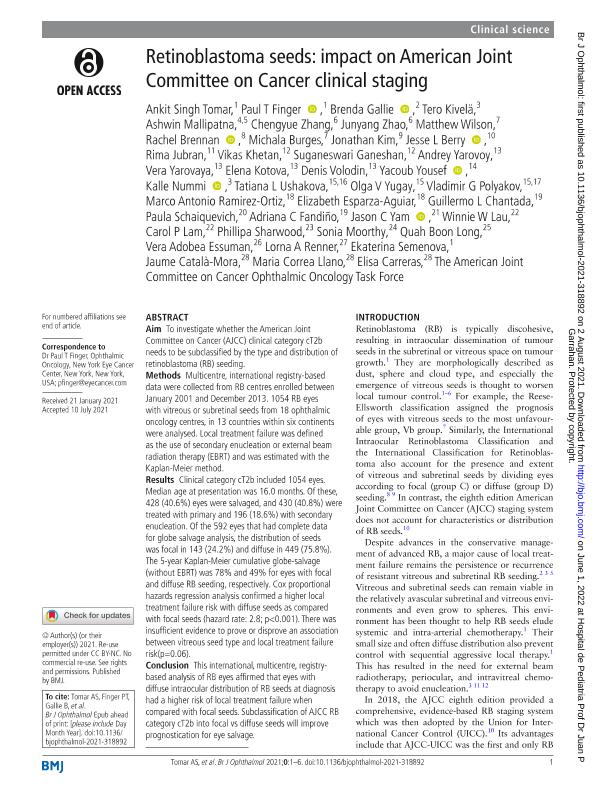Artículo
Retinoblastoma seeds: Impact on American Joint Committee on Cancer clinical staging
Tomar, Ankit Singh; Finger, Paul T.; Gallie, Brenda; Kivelä, Tero; Mallipatna, Ashwin; Zhang, Chengyue; Zhao, Junyang; Wilson, Matthew; Brennan, Rachel; Burges, Michala; Kim, Jonathan; Berry, Jesse L.; Jubran, Rima; Khetan, Vikas; Ganeshan, Suganeswari; Yarovoy, Andrey; Yarovaya, Vera; Kotova, Elena; Volodin, Denis; Yousef, Yacoub; Nummi, Kalle; Ushakova, Tatiana L.; Yugay, Olga V.; Polyakov, Vladimir G; Ramirez Ortiz, Marco Antonio; Esparza Aguiar, Elizabeth; Chantada, Guillermo Luis ; Schaiquevich, Paula Susana
; Schaiquevich, Paula Susana ; Fandiño, Adriana Cristina; Yam, Jason C.
; Fandiño, Adriana Cristina; Yam, Jason C.
 ; Schaiquevich, Paula Susana
; Schaiquevich, Paula Susana ; Fandiño, Adriana Cristina; Yam, Jason C.
; Fandiño, Adriana Cristina; Yam, Jason C.
Fecha de publicación:
08/2021
Editorial:
B M J Publishing Group
Revista:
British Journal Of Ophthalmology
ISSN:
0007-1161
Idioma:
Inglés
Tipo de recurso:
Artículo publicado
Clasificación temática:
Resumen
Aim To investigate whether the American Joint Committee on Cancer (AJCC) clinical category cT2b needs to be subclassified by the type and distribution of retinoblastoma (RB) seeding. Methods Multicentre, international registry-based data were collected from RB centres enrolled between January 2001 and December 2013. 1054 RB eyes with vitreous or subretinal seeds from 18 ophthalmic oncology centres, in 13 countries within six continents were analysed. Local treatment failure was defined as the use of secondary enucleation or external beam radiation therapy (EBRT) and was estimated with the Kaplan-Meier method. Results Clinical category cT2b included 1054 eyes. Median age at presentation was 16.0 months. Of these, 428 (40.6%) eyes were salvaged, and 430 (40.8%) were treated with primary and 196 (18.6%) with secondary enucleation. Of the 592 eyes that had complete data for globe salvage analysis, the distribution of seeds was focal in 143 (24.2%) and diffuse in 449 (75.8%). The 5-year Kaplan-Meier cumulative globe-salvage (without EBRT) was 78% and 49% for eyes with focal and diffuse RB seeding, respectively. Cox proportional hazards regression analysis confirmed a higher local treatment failure risk with diffuse seeds as compared with focal seeds (hazard rate: 2.8; p<0.001). There was insufficient evidence to prove or disprove an association between vitreous seed type and local treatment failure risk(p=0.06). Conclusion This international, multicentre, registry-based analysis of RB eyes affirmed that eyes with diffuse intraocular distribution of RB seeds at diagnosis had a higher risk of local treatment failure when compared with focal seeds. Subclassification of AJCC RB category cT2b into focal vs diffuse seeds will improve prognostication for eye salvage.
Palabras clave:
retinoblastoma
,
vitreous seeds
,
treatment
,
AJCC
Archivos asociados
Licencia
Identificadores
Colecciones
Articulos(SEDE CENTRAL)
Articulos de SEDE CENTRAL
Articulos de SEDE CENTRAL
Citación
Tomar, Ankit Singh; Finger, Paul T.; Gallie, Brenda; Kivelä, Tero; Mallipatna, Ashwin; et al.; Retinoblastoma seeds: Impact on American Joint Committee on Cancer clinical staging; B M J Publishing Group; British Journal Of Ophthalmology; 2021; 8-2021; 1-6
Compartir
Altmétricas



